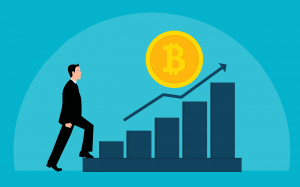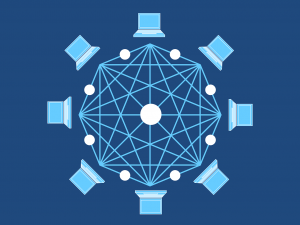What is Blockchain Technology? our previous post, introduced the key functions and characteristics of the blockchain technology, which we discussed in details.
To be precise, every topic discussed thus far in this series (the origins of money, digital payments, and the blockchain technology) will be recalled and applied to our knowledge of what exactly is bitcoin.
Key Takeaways on What is Bitcoin
- To recapitulate, bitcoin is a new sort of currency that provides you with anonymity, decentralization, security, speed, savings, and an anti-inflation mechanism built right into the system.
- While only a few lines of code can be seen in a computer, the system has been so cleverly built that more and more people are growing to trust it, consequently elevating its significance in the eyes of the public.
- This self-sustaining environment is enabled by the blockchain technology that underpins it, in which players are paid for maintaining and securing the system.
- People will flock to it as soon as it becomes safer, resulting in greater benefits for all participants in the long run.
What is Bitcoin
 Let us begin with the fundamentals. In the same way that commodities, representatives, and fiat money are types of currency, bitcoin is a sort of currency that lets us to hold, measure, and transfer wealth.
Let us begin with the fundamentals. In the same way that commodities, representatives, and fiat money are types of currency, bitcoin is a sort of currency that lets us to hold, measure, and transfer wealth.
Although bitcoin is not a real object, such as a piece of gold or a paper voucher,
It is totally digital and represented by code stored within a computer.
Many people are perplexed as to how anything intangible can have any monetary value at this moment.
Though humans once used commodities or goods with intrinsic worth as money, we eventually transitioned away from this practice and began using notes or vouchers instead.
Despite the fact that the paper itself was almost worthless, each note was backed by a promise that it could be exchanged for a specific amount of gold at any time in the future.
However, as time progressed, even the gold standard was abandoned in favor of fiat currency, which was eventually accepted.
In that case, how does it come to be that fiat currency is generally regarded as money today, when it is not backed by any commodity?
Essentially, it has value because it is based on trust. We have faith in the ability of our government to enforce the use of these notes, and we have faith in the ability of our fellow citizens to accept the currency.
To put it another way, value is produced when we all agree that something is worthy. It makes no difference in what shape it takes,
whether it is a coin, a piece of paper, or even computer code. Once it has been proven beyond doubt that anything can gain value from the faith that we place in it,
let’s look at why we can trust bitcoin in the absence of a central authority such as a government to back it up.
Digitization – The Life-force of Bitcoin
 Before we get into the technology and attributes that distinguish bitcoin as a trustworthy alternative to fiat currencies,
Before we get into the technology and attributes that distinguish bitcoin as a trustworthy alternative to fiat currencies,
Due to our never-ending effort to streamline the process of completing transactions, even the physical use and exchange of fiat money has been reduced in recent years.
We now use digital technology to record the transfer of wealth.
By storing our funds with a financial institution, we enable that institution to take advantage of network and mobile technology to promptly record transactions.
No physical cash needs to be transferred as long as there is a detailed and accurate record of who paid whom and when they did so.
Once again, the fact why this form of digital transaction system works is due to the element of trust involved.
We put our faith in our bank’s ability to accurately record transactions, to be consistent with these records, and to keep them safe from unauthorized tampering and alteration.
The only way for us to accept that money has been transmitted or received would be if we physically exchanged it with our hands in the absence of this trusted intermediary.
Again, this raises the question of how we can place our trust in a decentralized system such as bitcoin’s, in which a global network of users participates in these record-keeping activities.
What prohibits people from modifying records or changing codes in order to make it appear as though they have more money than they actually do?
In the end, we are all greedy and self-interested actors, and we all have our own agendas. As you may have figured by now, blockchain technology comes into play in this situation.
It was created with the intent of addressing all of these difficulties and more.
Bitcoin Vs Blockchain
 Let’s take a look at how bitcoin uses each of the blockchain’s fundamental characteristics to establish itself as a safe and secure alternative to traditional money.
Let’s take a look at how bitcoin uses each of the blockchain’s fundamental characteristics to establish itself as a safe and secure alternative to traditional money.
Centralization vs Decentralization of Bitcoin
 Before we can address the major question stated above, it is necessary to recognize that a centralized system has its own set of drawbacks to contend with as well.
Before we can address the major question stated above, it is necessary to recognize that a centralized system has its own set of drawbacks to contend with as well.
Putting your trust in someone or something, whether it’s the government or a bank, presupposes that they’ll do a good job.
The truth is, however, that is not always the case.
There have been numerous instances throughout history of governments totally mismanaging their fiscal and economic obligations, resulting in hyperinflation and, ultimately, the collapse of their own currency systems.
A similar number of examples may be found of financial or banking firms that have been unable to keep funds or transaction records secure.
Furthermore, several of them have been proven to purposefully and willfully deceive consumers and pilfer funds.
This is very concerning.
Part of the problem is from the entire control and authority that these institutions have over your records and financial assets, which is a source of contention.
In the real world, there is no reasonable method to monitor or control what they are doing with your money behind the scenes.
Bitcoin addresses this issue by storing all transactions on a distributed ledger known as a blockchain.
As a reminder, a blockchain is simply an uncentralized public ledger that is not controlled by a single individual or organization.
Every transaction can be easily traced and confirmed due to the public nature of this ledger, which eliminates the need to blindly rely on a central entity for security.
Furthermore, because there is no single point of failure, it is far more difficult (nearly impossible) for an attacker to tamper with these records.
Bitcoin’s virtual ledger is replicated in many locations throughout the world, each of which would need to be updated in order to bring the system into disrepute.
Let’s examine and enhance our knowledge of blockchain in order to better understand how it is feasible to have a publicly maintained record without having to worry about fraudulent or incorrect transactions.
Mining and security of Bitcoin are intertwined.
 In the article on blockchain technology, we explained that its name is a reference to the fact that it is made up of blocks of transaction data that are linked to one another as they are confirmed.
In the article on blockchain technology, we explained that its name is a reference to the fact that it is made up of blocks of transaction data that are linked to one another as they are confirmed.
Let’s look at an example to better understand the procedure.
You have one bitcoin, which you have transferred to a buddy.
Anyone can check to see if the funds in your account (wallet) are there, and if the transaction contains your unique signature, before proceeding.
They accomplish this through the use of the public key infrastructure, which was discussed in the preceding article.
Instead of false transactions being rejected, hundreds of verified transactions are bundled together to form blocks of transactions.
Several requirements must be met before a block may be formally added to the blockchain, thereby becoming a permanent part of the public record.
In this case, the most crucial skill is the ability to solve a mathematical puzzle.
This puzzle is extremely difficult and intricate, and it will take a large amount of computational power to complete it successfully.
Individuals or groups known as miners employ specialized equipment to assist in the resolution of such issues.
Oversimplified, the method can be explained as follows:
These computers repeatedly attempt different variables, known as nonces, until one of them provides the correct result.
The first miner to provide a valid answer is the one who gets to add his block to the chain of mining.
Several miners test the same nonce to ensure that they, too, have arrived at the correct answer.
This is done to ensure that the miner completed the work and is not simply attempting to add a block without actually giving his computer power.
This automatically establishes the miner’s validity by demonstrating that he or she has the right nonce,
which is nearly impossible to achieve without expending significant resources.
In the event that everything is correct, the new block is automatically appended to all copies of the blockchain.
Furthermore, as previously mentioned in the previous article, this right answer also happens to be a string of characters (hash value) that serves as a name or code to distinguish each block from the others in the collection.
Using the hash value from the previous block is an important part of solving the problem or arriving at the correct code.
It has the consequence of ensuring that every valid block contains a hash value that is inextricably linked to the previous and following blocks.
In other words, the blocks form a chain that connects them all together. Attempting to change a single block will cause the mathematical reasoning of the entire chain to be thrown off balance.
Returning to the mathematical puzzle, this process also serves as a deterrent for anyone who would do harm to the system.
The expense of solving the puzzle is so high that it is more cost effective to merely follow the rules at that point in time.
Why? Because completing the problem and receiving a reward is worthwhile.
Mining operations reward miners with a certain quantity of bitcoins for each authentic block they contribute to the chain.
Additionally, users must pay varied amounts as transaction fees each time they transfer their coins from one location to another.
Miners will prioritize these transactions, validate them, and add them to the blockchain in greater numbers if the fee paid is higher than a certain threshold.
Benefits of Bitcoin No one is Talking About
 A Deflationary Currency
A Deflationary Currency
The system is designed to allow for the mining of a total of a maximum of 21 million bitcoins in total.
As a result, bitcoin is considered a deflationary money. In other words, the value of bitcoin does not drop as a result of a central bank’s decision to print more money.
The fact that miners will no longer be compensated by the system when that time comes will not deter them from continuing their work because the transaction fees they earn from customers will keep them motivated to do so.
Lower Costs And Shorter Waiting Times
The decentralized nature of the system, which we discussed before, also results in reduced costs and shorter wait times.
When it comes to traditional finance, we must not only put our faith in third-party intermediaries to handle our funds in good faith, but we must also pay them for the privilege of doing so.
When compared to the fees paid to miners, these charges are significantly greater.
Furthermore, in order for money to flow across borders, it must frequently pass through a slew of organizations and processes, resulting in higher wait periods.
With bitcoin, any money you transfer goes directly to the person who receives it.
Anonymity
Another advantage that appears to be illogical at first is the ability to remain anonymous.
You see, while the blockchain, or record of transactions, is completely public and freely accessible for anybody to view, the identities of those who participated in the transactions are not.
As previously stated, transactions are attached to one-of-a-kind signatures that work similarly to usernames, rather than to actual legal names.
This helps to safeguard your privacy, which is especially important in a world where governments are progressively encroaching on our personal lives.
What moves Bitcoin’s price?
The fact that Bitcoin is a decentralized currency means that it is not subject to many of the economic and political challenges that plague traditional currencies.
However, as a market that is still in its infancy, there is a great deal of unpredictability that is unique to the cryptocurrency market.
Any one of the elements listed below has the potential to have an immediate and major impact on its pricing.
- Bitcoin supply
- BTC Market cap
- Integration
- Industry adoption
- Key events
If you’d want to learn more about Bitcoin’s competitors, check read this article:
NEXT ARTICLE: Everything You Need to Know About Altcoins Explained.
See what others are reading

 A Deflationary Currency
A Deflationary Currency
